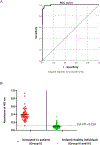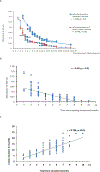ELISA-based evaluation of antibody response to Leishmania in a region endemic for cutaneous leishmaniasis
- PMID: 35836368
- PMCID: PMC9481270
- DOI: 10.1111/pim.12940
ELISA-based evaluation of antibody response to Leishmania in a region endemic for cutaneous leishmaniasis
Abstract
Leishmaniasis includes several clinical forms. While routine diagnosis of cutaneous leishmaniasis (CL) is by microscopy, an antibody response to CL has been reported in several recent studies. This study evaluated anti-leishmanial immunoglobulin G (IgG) antibody responses as a biomarker of active leishmaniasis and a measure of exposure to Leishmania. Sera from 50 untreated CL patients, 140 patients under treatment and 280 healthy individuals residing in endemic regions collected as part of an epidemiological survey, was analysed with an enzyme-linked immunosorbent assay established in-house using receiver operator characteristic curve at optimized cut-off value. The assay showed high performance as a diagnostic tool in identifying exposure in endemic individuals (sensitivity: 98%, specificity: 90.3%). All patients showed lower antibody levels over time since onset of lesion/s. Antibody levels were higher (p ˂ .01) and persisted for a longer period in untreated patients. In patients under treatment, the level of anti-IgG antibodies was negatively correlated with the total duration the patient had been on treatment. The anti-leishmanial IgG response in Leishmania donovani-induced CL is transient and is unlikely to confer protective immunity. Optimized serological assays may be useful in endemic settings for diagnosis and monitoring the treatment response in CL.
Keywords: ELISA; IgG antibodies; L. donovani; biomarker; cutaneous leishmaniasis; serodiagnosis.
© 2022 John Wiley & Sons Ltd.
Figures




Similar articles
-
Serological studies on rK39 negative Visceral Leishmaniasis in an endemic focus of Leishmania donovani induced Cutaneous Leishmaniasis.Diagn Microbiol Infect Dis. 2023 Mar;105(3):115873. doi: 10.1016/j.diagmicrobio.2022.115873. Epub 2022 Nov 24. Diagn Microbiol Infect Dis. 2023. PMID: 36543026
-
First Serological Study Revealing High Humoral Response and Evidence for Antigenic Heterogeneity in Leishmania donovani Induced CL in Sri Lanka.Biomed Res Int. 2020 Sep 29;2020:5271657. doi: 10.1155/2020/5271657. eCollection 2020. Biomed Res Int. 2020. PMID: 33145352 Free PMC article.
-
Specific K39 antibody response and its persistence after treatment in patients with imported leishmaniasis.Parasitol Res. 2016 Feb;115(2):761-9. doi: 10.1007/s00436-015-4801-8. Epub 2015 Oct 28. Parasitol Res. 2016. PMID: 26508007 Free PMC article.
-
Serodiagnosis of anthroponotic cutaneous leishmaniasis (ACL) caused by Leishmania tropica in Sanliurfa Province, Turkey, where ACL Is highly endemic.Clin Vaccine Immunol. 2007 Nov;14(11):1409-15. doi: 10.1128/CVI.00133-07. Epub 2007 Aug 29. Clin Vaccine Immunol. 2007. PMID: 17761525 Free PMC article.
-
Serodiagnosis of leishmaniasis.Crit Rev Microbiol. 1995;21(2):123-52. doi: 10.3109/10408419509113537. Crit Rev Microbiol. 1995. PMID: 7639932 Review.
Cited by
-
The use of recombinant K39, KMP11, and crude antigen-based indirect ELISA as a serological diagnostic tool and a measure of exposure for cutaneous leishmaniasis in Sri Lanka.Parasitol Res. 2023 Dec 29;123(1):77. doi: 10.1007/s00436-023-08103-y. Parasitol Res. 2023. PMID: 38157062 Free PMC article.
-
Leishmania Infection during Ruxolitinib Treatment: The Cytokines-Based Immune Response in the Setting of Immunocompromised Patients.J Clin Med. 2023 Jan 11;12(2):578. doi: 10.3390/jcm12020578. J Clin Med. 2023. PMID: 36675507 Free PMC article.
-
Diagnostic Tools for Cutaneous Leishmaniasis Caused by Leishmania donovani: A Narrative Review.Diagnostics (Basel). 2023 Sep 18;13(18):2989. doi: 10.3390/diagnostics13182989. Diagnostics (Basel). 2023. PMID: 37761356 Free PMC article. Review.
References
-
- WHO. Leishmaniasis. 2022. https://www.who.int/news-room/fact-sheets/detail/leishmaniasis. Accessed February 04,2022.
-
- Sharma U, Singh S. Immunobiology of leishmaniasis. Indian J Exp Biol. 2009;47(6 SPEC. ISS.):412–23. - PubMed
Publication types
MeSH terms
Substances
Grants and funding
LinkOut - more resources
Full Text Sources

